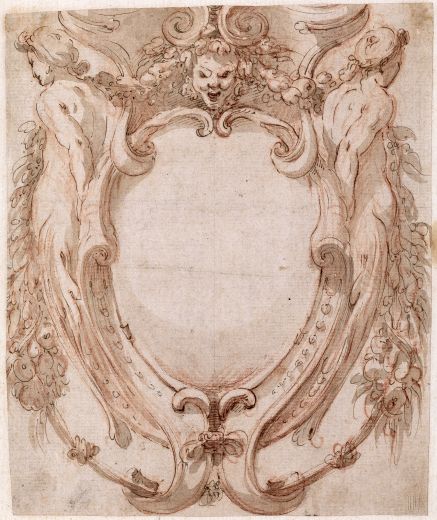Design for a Cartouche with two Female Herms and a Mask.
Agostino Mitelli
* 1609 in Bologna † 1660 in Madrid
Pen and ink, red chalk, brown wash; the centre of the cartouche squared in black chalk. Size of sheet: 19.7 x 16.3 cm.
Provenance: Sale: Berlin, Gerhard Rosen, 16th-20th May 1960, lot. 290;
Mr. Herbert List, Munich;
Stiftung Wolfgang Ratjen, Vaduz (inv. R455), until 1991;
Private collection, Germany.
Literature: R. Harprath, J. Rapp and W. Ratjen (eds.), Italienische Zeichnungen des 16.–18. Jahrhunderts, eine Ausstellung zum Andenken an Herbert List, Staatliche Graphische Sammlung, Munich, Kupferstichkabinett, Berlin, and Hamburger Kunsthalle, Hamburg, 1977, cat. no. 76, illustrated (cat. entry by S. Jakob).
This lively drawing for a cartouche is typical of Agostino Mitelli’s extravagant inventions. Its composition corresponds in reverse to an etching known from impressions at the Graphische Sammlung, Düsseldorf, the Kunstbibliothek, Berlin, and the Victoria and Albert Museum, London. The print belongs to a set of twelve studies for decorative cartouches accompanied by a title-page inscribed Agostino Mitelli inven. F., and printed in Rome by Giovanni Giacomo De Rossi (1)
A group of stylistically comparable drawings of architectural ornament by Mitelli’s hand are held at the Kunstbibliothek, Berlin. Amongst these, a vigorous pen study of a Satyr appears close in both technique and handling, confirming the authorship of our Design for a Cartouche (2).
A drawing attributed to Mitelli at Windsor Castle shows the same composition as the present sheet but in reverse direction and is clearly a copy after the corresponding print (3). In contrast with the mechanically drawn Windsor sheet, our drawing fully expresses the freedom of Mitelli’s flowing pen lines, particularly evident in the foliage of the garlands at either side of the cartouche.
Having trained in Bologna in the studio of the painter Girolamo Curti (1570-1631), regarded as the first quadraturista, Mitelli went on to forge a career based on his specialist knowledge of illusionistic decorative surrounds, in which he combined technical dexterity and conceptual ingenuity. While his designs were widely disseminated thanks to prints made by his son Giovanni Maria, Mitelli’s drawings have not survived in such large numbers and are for the most part known today through copies.
(1) Katalog der Ornamentstichsammlung der Staatlichen Kunstbibliothek Berlin, Staatliche Kunstbibliothek Berlin, Berlin, 1939, cat. no. 572.
(2) S. Jacob 1975, cat. no. 634.
(3) Inv. RCIN 901564.
Sold
